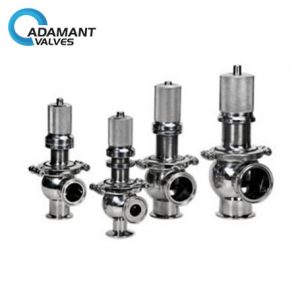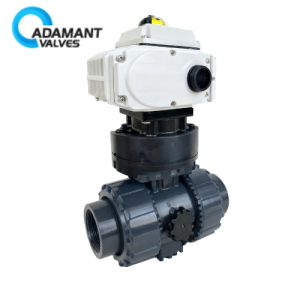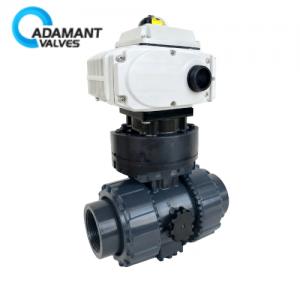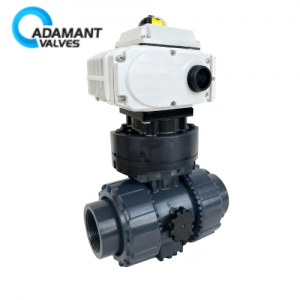List of Valves
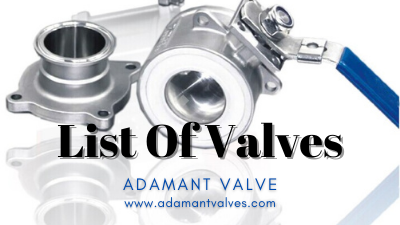
What are Valves in Engineering?
Valves are devices in fluid or gas processing systems used to control, regulate, or direct the flow of the medium by opening and closing pipelines. They can stop or start the flow, vary the amount of flow, control the flow direction, regulate the downstream system or process pressure, and relieve the system when it’s over or under standard pressure.
How Many Valve Types are there?
All of these functions require different types of valves to execute them, and various fluids or gases necessitate further valve variations. Hundreds or even thousands of different types of valves must exist, but they can all be classified into three different groups: Linear Motion, Rotary Motion, and Quarter-Turn Valves.
Let’s take a look in our list of valves and learn about each one, including ball valves, butterfly valves, check valves, diaphragm valves, gate valves, global valves, needle valves, pinch valves, plug valves, and relief valves.

What are the Types of Valves?
The list of valves below offers an introduction to the function and applications of 10 of the most common types of valves.
1. Ball Valves
Ball valves are used for on/off control without loss of pressure, making them ideal for quick closing performance. A 90° turn offers a full closure angle, compared to the multiple turns required for most manual valves.
A ball valve is a rotary motion valve that uses a ball-shaped disc to stop or start flow. When the hole through the ball is in line with the valve body inlet and outlet, the valve opens and fluid passes through. When the hole is perpendicular to the inlet and outlet, the flow is stopped.
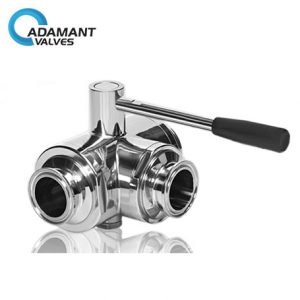
2. Butterfly Valves
Butterfly valves provide flow control in large pipe diameters.
A butterfly valve is a rotary motion valve that is used to stop, regulate, and start the flow. Like all 1/4 turn valves, the butterfly valve is fast-acting. The pressure drop across the butterfly valve is very low when the valve is fully open, so butterfly valves are very well-suited for handling large flows of liquids or gases at relatively low pressures.
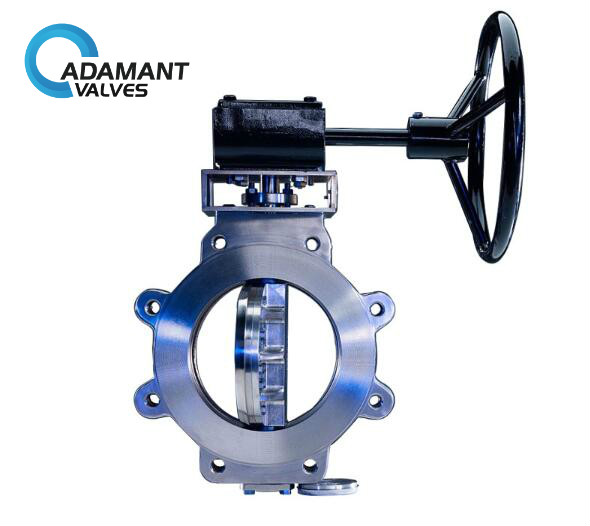
3. Check Valves
Check valves or non-return valves allow the fluid to pass in one direction.
The check valve is designed to prevent the reversal of flow in a piping system, and it is activated by the flow of material in the pipeline. The pressure of the fluid passing through the system opens the valve, while any reversal of flow will close the valve.
The most common types of check valves are the swing, tilting, piston, and stop valves. They are used in different circumstances, depending upon the system pressure, temperature, and flow requirements. For example, the swing check valve has a relatively low pressure drop, so they are well-suited for medium velocity, high volume flow applications.
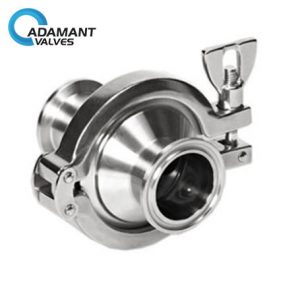
4. Diaphragm valve
Diaphragm valves control the flow by moving a diaphragm through the valve using upstream pressure, downstream pressure, or an external source (for example, pneumatic, hydraulic, etc.) to change the position of the diaphragm.
A diaphragm valve is a linear motion type valve that is used to start, regulate, or stop fluid flow. A flexible diaphragm can be raised or lowered onto the valve seat in order to open or close the valve.
One key advantage of diaphragm valves is that only the flexible diaphragm and internal valve flow passages are exposed to the flowing medium. This makes it well-suited for handling corrosive fluids, fibrous slurries, radioactive fluids, or other applications that require contamination-free performance.
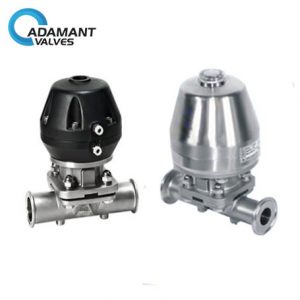
5. Gate Valves
Gate valves are mainly used for on/off control in low-pressure drop applications.
Gate valves are linear motion-type valves used to start or stop the flow but are not suitable for regulating flow.
The major advantages of gate valves are a cost-effective, simple design, and very low-pressure drop across the valve when it is fully open. When the valve is fully open, the gate valve’s disc is completely removed from the pipeline’s flow, which allows virtually no resistance.
Related: The Advantages and Disadvantages of Gate Valve
6. Globe Valves
Globe valves are linear motion valves used to stop, start, and regulate fluid flow. They’re ideal for applications that require strict flow regulation.
There are four main globe valve designs: straight flow, angle flow, cross-flow, and Y-flow.
The globe valve generally yields much less seat leakage because the disc to seat ring contact is at right angles, which allows closing the valve tightly. Globe valves are always installed with the system pressure on the underside of the valve seat. This makes it easier to open the valve, and also removes the pressure on the stem, packing, and bonnet when the valve is closed.
The biggest disadvantage of globe valves is that there is a relatively large pressure drop across the valve. In addition, large globe valve sizes require considerable power to operate and are especially noisy in high-pressure applications. Globe valves are also often heavier than other types of valves with the same flow rating.
7. Needle Valves
Needle valves provide precise flow control and flow metering with accurate flow rates of fluids and gases.
Needle valves are used to make relatively fine adjustments in the amount of fluid flow. Its most distinguishing characteristic is the long, tapered needle-like point on the end of the valve’s stem, which acts as a disc. The longer part of the needle is smaller than the orifice in the valve seat and passes through the orifice before the needle seats. This arrangement permits a very gradual increase or decrease in the size of the opening.
Needle valves are usually used as metering valves because the number of turns of the handwheel can be correlated to the amount of flow.
8. Pinch Valves
Pinch valves provide regulation and control of sludge flow, slurries, and fluids with excess suspended solids.
The pinch valve’s simple design renders it a high-value piece of equipment. The pinch control valve consists of a sleeve molded of rubber or other synthetic material and a pinching mechanism. Pinch valves can be used to start, stop, or regulate flow. However, the effective throttling range is usually between 10% and 95% of the rated flow capacity.
Pinch valves are well-suited for handling slurries with large amounts of suspended solids. They can also be used where corrosion or metal contamination of the flow medium might be a problem.
9. Plug Valves
Plug valves are fine valves used for on/off control but with a slight loss of load.
A plug valve is a rotary motion valve used to start or stop flow. It is named by its disc shape, which resembles a plug, and its design is very similar to a ball valve. In the open position, the passage in the plug lines up with the inlet and outlet ports of the valve body. When the plug is turned 90 degrees from the open position, the solid part of the plug blocks the ports and stops the flow. When the plug valve is fully open, there is a very low-pressure drop across the valve.
Plug valves are often used in non-throttling, on-off applications, particularly where the valve must be operated frequently. The valve is also easy to adapt for multiport applications. The use of a multiport valve, depending upon the number of ports in the plug valve, eliminates the need for as many as four conventional shutoff valves, making it a considerable cost and space-saving valve.
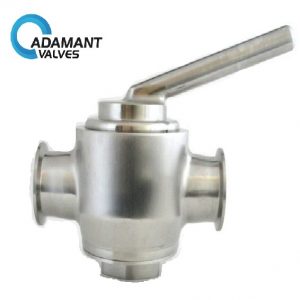
10. Relief and Safety Valves
Relief and safety valves prevent equipment damage by relieving accidental system over pressurization.
A relief valve gradually opens as the inlet pressure increases above the setpoint. The valve only opens enough to relieve the overpressure condition, whereas the safety valve rapidly pops fully open as soon as the pressure setting is reached, and it will stay fully open until the pressure drops below a preset pressure.
These valves are very well-suited for opening and closing operations. They can be used to start or stop flow, but are not suitable for regulating flow.
